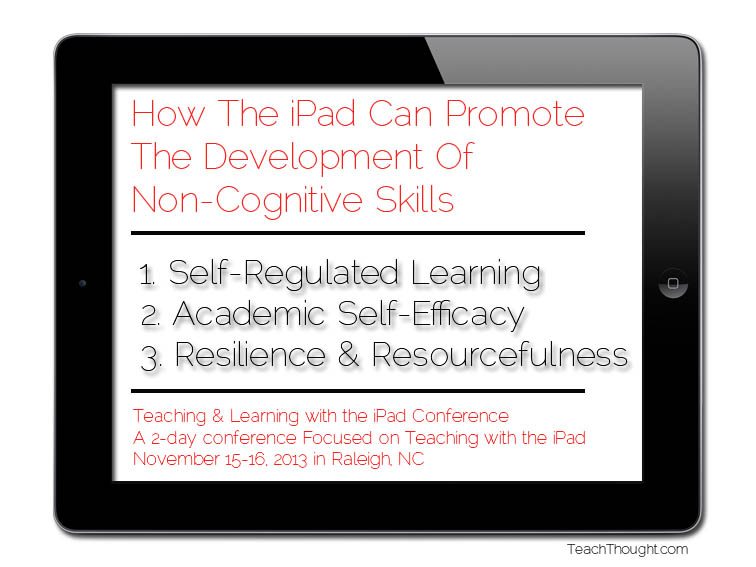
This content is sponsored by the Teaching & Learning with the iPad Conference November 15-16, 2013 in Raleigh, NC, a 2-day conference dedicated exclusively to better learning with the iPad, coordinated and presented by teachers, for teachers.
How iPad Can Promote Non-Cognitive Skill Development
by Timothy Hall, Franklin Academy High School in North Carolina
Although there are many reasons to use the iPads in the classroom, the development of non-cognitive skills is one the educators should consider as well with the implementation of the device. Since the early 1980s, educators and employers across many disciplines have stressed the importance of non-cognitive skills although the focus of most educational research has been dedicated to the relationship between cognitive skills and student achievement.
However, recent studies have demonstrated that non-cognitive skills might be as important – or even more so – as cognitive skills in determining educational outcomes. Howard Gardner has gone even further by suggesting that in an increasingly interdependent globalized world “our survival […] may depend on the cultivation of this pentad of mental dispositions.”
Recently, a collaborative study by the Research Triangle Institute (RTI) and the Spencer Foundation has sought to categorize non-cognitive skills that populate the educational research. They developed the following -categories including motivation, effort, self-regulated learning, self-efficacy, academic self-concept, social behavior, and resilience. Of these categories, it is self-regulated learning, academic self-efficacy, and resilience that most benefit from 1:1 iPad implementation in schools.
Self-Regulated Learning
Self-regulated learning encompasses a student’s ability to evaluate a task, apply problem-solving strategies, and revise strategies based on outcomes. Students continually develop this noncognitive with the iPads as they learn to work with new apps with minimal instruction. The problem-solving process is quick and immediate promoting its continually acquisition.
Classroom examples include simple readily content specific apps which allow the student to problem solve with immediate feedback on their progress like the math apps Mathmateer and Math Blaster or the social studies app Oregon Trail. These, of course, are just a few examples. There is a plethora of content specific apps available for educators on the iTunes apps store.
Academic Self-Efficacy
Academic self-efficacy is a student’s belief that he/she can complete a subject specific task. If a student cannot complete a task or assignment, it is not because some intellectual deficit but because of lack of enough information. The iPad reinforces this non-cognitive continually in the classroom as students use the iPad as reference device. When students miss a question, an external/internal dialogue should take place much like the following: “If I could have searched Google, I would have gotten the answer.”
This dialogue once internalized after reinforcement can develop academic self-efficacy. In the past before iPads (Bi) in the classroom, this internalization was not as accessible to students. An educator can help promote this internalization process by continually asking students the question, “To answer this question correctly, what information did you need? Where are some sources to begin with in the acquisition of that information?”
This line of questioning can reinforce the non-cognitive of academic self-efficacy in students.
Resilience
The last non-cognitive which the iPads help to develop in students is resilience. Resilience refers to educational achievement despite risk factors that can include academic, demographic, and/or psychological factors. Inherently, using new technology is a risk for the user. With the iPad, the technology is always new since iPad iOS and app updates are frequent. This continually change associated with the iPad forces students to continually be aware, be resourceful, and take risks.
To aid this change and non-cognitive, teachers need to create the environment in the classroom of continually technological experimentation. This could have many approaches but two are very easily implemented. Teachers need to introduce new content specific apps to the students on a regular basis. In addition, educators can focus assignments on the use of unconventional apps in place of the conventional.
For example, a presentation assignment cannot be in a PowerPoint or Keynote format; it must use Slid.es, SlideRocket, SlideSnack, SlideServe, 9Slides, Zoho Show, Reel, Prezi, and/or Powtoons. Each change will force new resourcefulness, awareness, and risk-taking upon the students, all important non-cognitive characteristics.
There are many reasons educators should considering iPads for their students–the development of self-regulated learning, academic self-efficacy, and resilience among them. A bonus? The development of these non-cognitives through the iPads does not require an overhaul of a teacher’s existing classroom only an additional perspective to be aware as one develops a strong learning environment.
Image attribution flickr user flickeringbrad